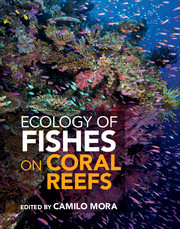Book contents
- Frontmatter
- Contents
- Preface
- Foreword
- List of contributors
- PART I BASIC ECOLOGY
- PART II PATTERNS AND PROCESSES
- PART III HUMAN FINGERPRINTS
- 13 Effects of climate change on coral reef fishes
- 14 Effects of fishing on the fishes and habitat of coral reefs
- 15 Effects of sedimentation, eutrophication, and chemical pollution on coral reef fishes
- 16 Impacts of invasive species on coral reef fishes
- 17 Cashing in on coral reefs: the implications of exporting reef fishes
- PART IV CONSERVATION
- PART V DEBATES AND PARADIGM SHIFTS
- References
- Index
16 - Impacts of invasive species on coral reef fishes
from PART III - HUMAN FINGERPRINTS
Published online by Cambridge University Press: 05 May 2015
- Frontmatter
- Contents
- Preface
- Foreword
- List of contributors
- PART I BASIC ECOLOGY
- PART II PATTERNS AND PROCESSES
- PART III HUMAN FINGERPRINTS
- 13 Effects of climate change on coral reef fishes
- 14 Effects of fishing on the fishes and habitat of coral reefs
- 15 Effects of sedimentation, eutrophication, and chemical pollution on coral reef fishes
- 16 Impacts of invasive species on coral reef fishes
- 17 Cashing in on coral reefs: the implications of exporting reef fishes
- PART IV CONSERVATION
- PART V DEBATES AND PARADIGM SHIFTS
- References
- Index
Summary
Non-indigenous species are found in most marine regions of the world, but relatively few have been reported on coral reefs. The majority of known reef invaders are fishes, probably because this group is well known and often monitored in coral habitats. There is little information on the repercussions of invasive invertebrates or algae on reef fish. Our understanding of the impacts of invasive fishes is largely limited to those of predatory fish including bluestripe snapper and peacock grouper, introduced to Hawaiʿi, and Indo-Pacific lionfish which were introduced to the western Atlantic. These species have spread rapidly from initial introduction sites, and they consume a wide range of native coral reef fishes. The direct impacts of invaders on Hawaiian reefs are not known, but lionfish have caused substantial declines in the abundance and biomass of prey species at some sites in the Atlantic. The long-term effects of predatory fish invasion on reef fish populations and coral reef habitats have the potential to be severe. Predatory fish invasions are yielding insights into the potentially weak role of biotic resistance and the importance of propagule pressure in determining coral reef invasibility. However, there are currently too few well-studied invasions on coral reefs to assess the generality of these conclusions.
INVASION ECOLOGY: THE SCIENCE OF ORGANISMS IN THE WRONG PLACE
As the globalization of trade proceeds, species are transported beyond their native ranges increasingly frequently [415, 2184]. Some become established in novel environments, and a small subset of species, generally categorized as invasive, increase in range and abundance, often with concomitant effects on the fauna and flora of the recipient habitats [2589].
Long-standing challenges for ecologists have been to predict when invasions will occur and what impacts they will have. Are there characteristics of species that make them particularly good at invading, or features of communities that make them particularly invasible? Although some characteristics have been identified [e.g. 1070, 1370, 1485], we still do not have definitive answers to these questions.
- Type
- Chapter
- Information
- Ecology of Fishes on Coral Reefs , pp. 154 - 165Publisher: Cambridge University PressPrint publication year: 2015
- 3
- Cited by

